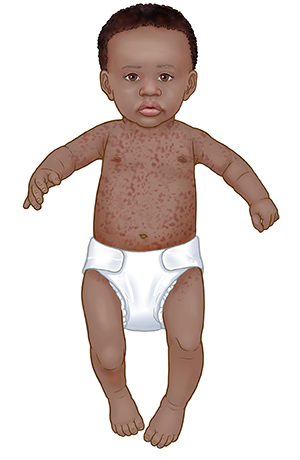When Your Child Has Roseola
Roseola is a common viral infection in children under age 2. It is also known as sixth disease. Roseola is not a major health problem. It goes away on its own without treatment. But you can help your child feel better.
 |
| Roseola on light skin. |
 |
| Roseola on dark skin. |
What causes roseola?
Roseola is most often caused by a virus in the human herpes virus family. It is spread by droplets in the air when an infected person sneezes or coughs. It most often affects children ages 6 months to 2 years.
What are the symptoms of roseola?
Symptoms happen in stages. The stages are:
-
Stage 1. Your child will have 3 to 7 days of high fever, such as 102°F ( 39°C) to 104°F ( 40°C). Your child is likely to feel cranky and uncomfortable during the fever. While your child has a fever, they can spread the virus to other children.
-
Stage 2. A rash appears on the neck down to the torso after the fever goes away. The rash is red and can be raised or flat. It may spread to the face or arms and legs. The rash does not hurt. It tends to get better and worse over 3 to 4 days. Your child may feel cranky or itchy during the rash stage of roseola. They are not contagious during the rash stage.
How is roseola diagnosed?
There is no test for roseola. It can’t be diagnosed until the fever has gone away and the rash has shown up. Your child’s healthcare provider will examine your child. In some cases, a child may have some tests to check for other causes of fever.
How is roseola treated?
Roseola will go away on its own. To help your child feel better:
-
Make sure they get plenty of rest and fluids.
-
Give acetaminophen or ibuprofen to help relieve fever or discomfort, if advised by the healthcare provider. Do not give ibuprofen to a baby age 6 months or younger, or to a child who is dehydrated or vomiting often. Don’t give your child aspirin. Giving aspirin to a child with a fever or viral infection could cause a serious condition called Reye syndrome.
-
Give your child an anti-itch medicine (antihistamine) if the rash is itchy.
Returning to daycare
Once the fever has been gone for 24 hours, your child is no longer contagious. So even if your child still has the rash, they may go to daycare unless the healthcare provider tells you otherwise..
What are long-term concerns?
Roseola rarely becomes a long-term problem for children who are otherwise healthy.
Call your child’s healthcare provider
Contact the healthcare provider right away if your child has any of these:
-
Fever (see Fever and children below)
-
A seizure caused by the fever
-
Fever that returns after rash has gone away
-
Rash that gets much worse or does not begin to fade after 4 to 5 days
-
Rash that lasts longer than several weeks
Fever and children
Use a digital thermometer to check your child’s temperature. Don’t use a mercury thermometer. There are different kinds and uses of digital thermometers. They include:
-
Rectal. For children younger than 3 years, a rectal temperature is the most accurate.
-
Forehead (temporal). This works for children age 3 months and older. If a child under 3 months old has signs of illness, this can be used for a first pass. The provider may want to confirm with a rectal temperature.
-
Ear (tympanic). Ear temperatures are accurate after 6 months of age, but not before.
-
Armpit (axillary). This is the least reliable but may be used for a first pass to check a child of any age with signs of illness. The provider may want to confirm with a rectal temperature.
-
Mouth (oral). Don’t use a thermometer in your child’s mouth until they are at least 4 years old.
Use the rectal thermometer with care. Follow the product maker’s directions for correct use. Insert it gently. Label it and make sure it’s not used in the mouth. It may pass on germs from the stool. If you don’t feel OK using a rectal thermometer, ask the healthcare provider what type to use instead. When you talk with any healthcare provider about your child’s fever, tell them which type you used.
Below are guidelines to know if your young child has a fever. Your child’s healthcare provider may give you different numbers for your child. Follow your provider’s specific instructions.
Fever readings for a baby under 3 months old:
-
First, ask your child’s healthcare provider how you should take the temperature.
-
Rectal or forehead: 100.4°F (38°C) or higher
-
Armpit: 99°F (37.2°C) or higher
Fever readings for a child age 3 months to 36 months (3 years):
-
Rectal, forehead, or ear: 102°F (38.9°C) or higher
-
Armpit: 101°F (38.3°C) or higher
Call the healthcare provider in these cases:
-
Repeated temperature of 104°F (40°C) or higher in a child of any age
-
Fever of 100.4° (38°C) or higher in baby younger than 3 months
-
Fever that lasts more than 24 hours in a child under age 2
-
Fever that lasts for 3 days in a child age 2 or older
Online Medical Reviewer:
L Renee Watson MSN RN
Online Medical Reviewer:
Michael Lehrer MD
Online Medical Reviewer:
Rita Sather RN
Date Last Reviewed:
5/1/2022
© 2000-2024 The StayWell Company, LLC. All rights reserved. This information is not intended as a substitute for professional medical care. Always follow your healthcare professional's instructions.